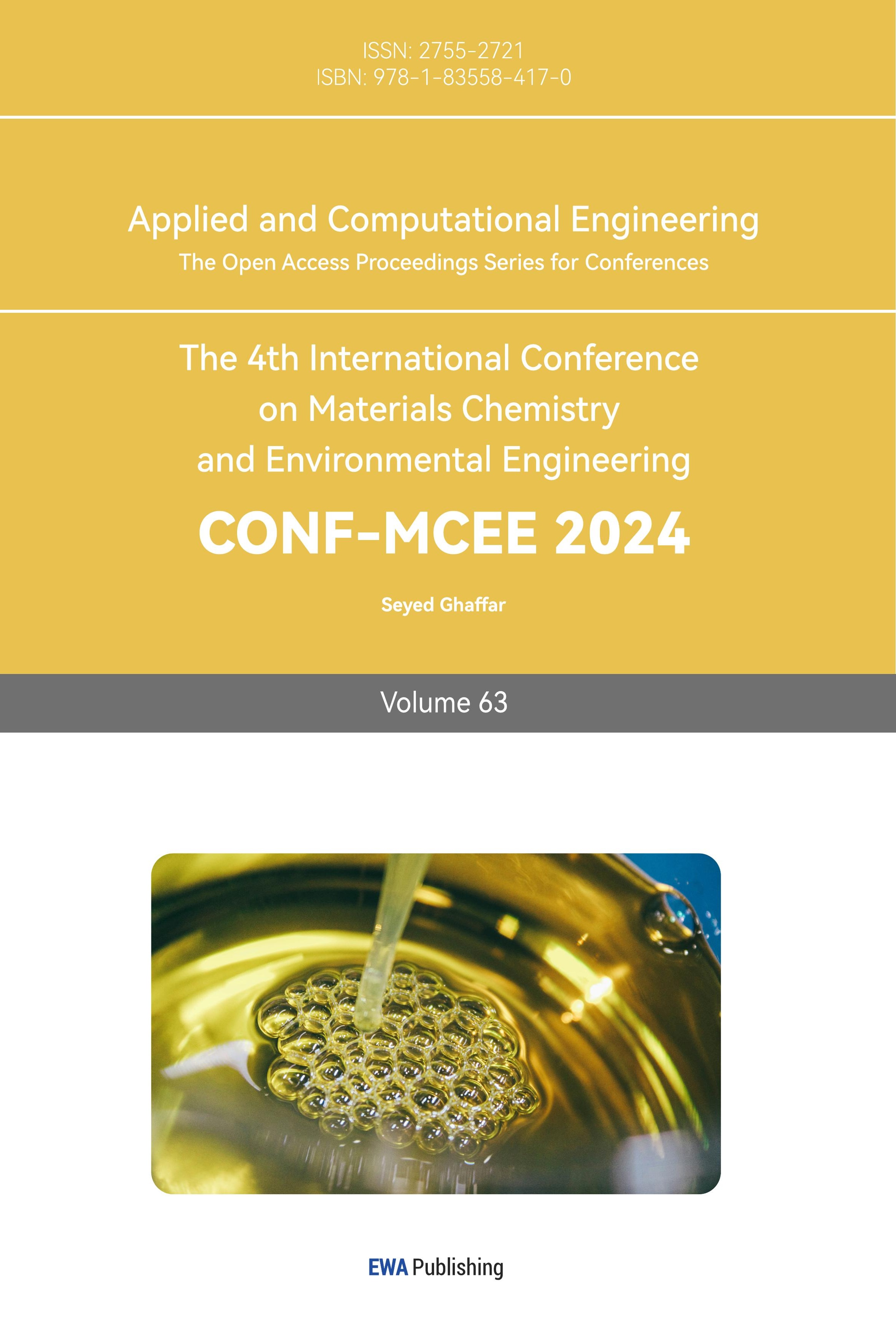1. Introduction
1.1. Introduction to superconductivity
Superconductors, under their critical temperature, demonstrate zero electrical resistance and total magnetic field expulsion. These properties are shaped by the transition temperature, current capacity, and external magnetic field strength. Superconductors fall into two categories: Type I and Type II, each with unique mechanisms, characteristics, and fabrication methods, posing distinct application challenges. Type II superconductors, despite having higher transition temperatures than Type I, still operate under ambient conditions. Therefore, developing room-temperature superconductors is pivotal for practical superconducting applications. This article offers a comprehensive analysis of superconductors, simplifying complexities for newcomers and advancing research and technology in this field.
Superconductivity, characterized by zero resistance and perfect diamagnetism, allows superconductors to conduct electricity without loss and repel external magnetic fields. Magnetic fields in superconductors decrease rapidly, affected by factors like temperature, and their penetration depth is crucial. An example is magnetic levitation in maglev trains, a direct application of superconductivity's properties.
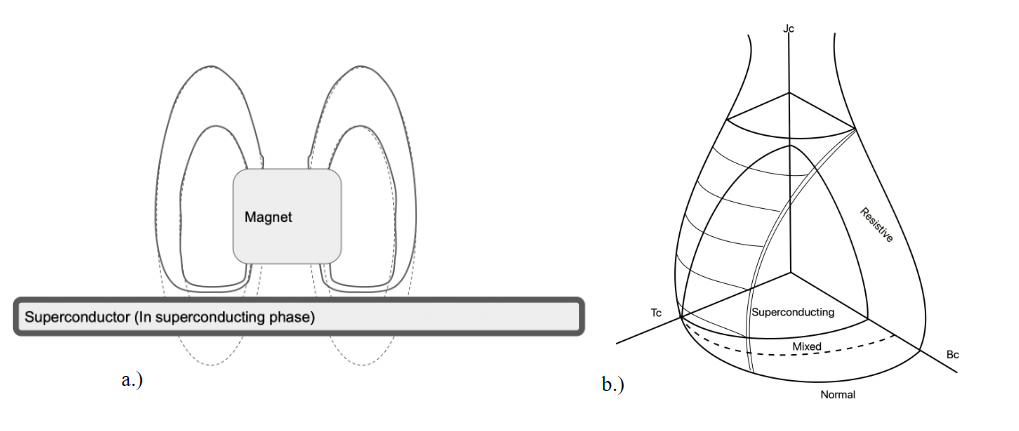
Figure 1. Schematic diagram of the properties of superconductors. Figure 1a (left): The superconductor repels a magnet's magnetic field lines, altering their shape. Figure 1b (right): TBJ phase diagram of type II superconductor [1].
Superconductors exhibit near-ideal properties under certain conditions but are limited by critical factors: temperature, current density, and magnetic field strength. Superconductivity loss occurs with high temperature, excessive current density, or strong magnetic fields. The Temperature-Current Density-Magnetic Field (TBJ) diagram (Figure 1b) shows the relationship among these parameters. Superconductivity is maintained when temperature, current density, and magnetic field are within the superconducting phase space, emphasizing the challenge of sustaining superconductivity and identifying key areas for enhancing practical use.
Superconductors, varying in properties and constraints, are broadly classified into Type 1 and high-temperature Type 2. Type 1 superconductors, single-element substances, become superconducting at extremely low temperatures, showing complete diamagnetism. High-temperature superconductors, typically multi-element, superconductors at higher temperatures and exhibit a 'mixed' phase between superconducting and normal states. This feature enables Type 2 superconductors to retain partial superconductivity under less-than-ideal conditions, increasing their practical utility and paving the way for technological progress in the field.
Research in superconductivity has intensely studied the physical properties of superconductors, leading to the discovery of diverse types within the Type 1 and Type 2 categories. A primary objective has been to increase the superconducting transition temperature, essential for achieving superconductivity. Various methods have been proposed and implemented toward this goal, significantly enhancing our understanding of these materials. This advancement in knowledge has broadened the potential applications of superconductors across multiple fields. Efforts to elevate the transition temperature are key to enabling more practical and varied uses of superconductors. The continuous progress in this research is crucial for further developments in superconductivity, potentially opening new technological possibilities.
1.2. The significance of high-temperature superconductivity
Superconductivity, transcending a mere physical phenomenon, offers significant potential for practical applications, particularly in energy transmission and magnet technology, thanks to its unique zero electrical resistance and complete diamagnetism. However, the requirement for low temperatures limits its broader application, making high-temperature superconductors a research priority for practical use and widespread adoption.
Superconductors’ zero-resistance characteristic allows lossless energy transmission, enhancing environmental protection and energy efficiency. This trait enables efficient current transmission and energy utilization. Their diamagnetic properties enable maglev trains to levitate. With high current capacity and operation at sub-room temperatures, superconductors contribute to stable magnetic fields, proving invaluable in MRI, quantum computing, and particle accelerators.
Research on superconductors also delves into material microstructure, advancing our understanding of material characteristics and aiding new material development. A notable example is the 2010 achievement of superconductivity in FeTe films using low-temperature oxygen doping, altering iron's valence state from 2+ to 3+ [2]. Studies show that changes in superconductors' electronic states often correlate with structural changes, merging solid-state physics and materials science, and suggesting that superconductor advancements can provide deeper insights into material property principles.
1.3. Paper framework
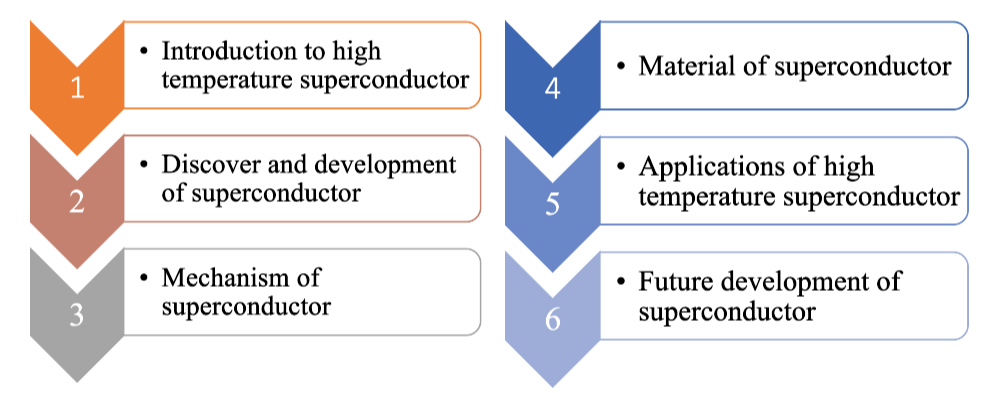
Figure 2. The framework of this paper, with six numbers corresponding to the six major parts.
Superconductor research, over a century old, has diversified into multiple focuses and subfields. This article aims to provide a systematic review of the evolution of superconductors, covering seven core theoretical models, three superconductor types, their applications, and future research directions. This comprehensive approach offers an in-depth understanding of the field, from foundational theories to practical applications and upcoming research trends.
Superconductor development is marked by three key stages. The initial discovery of traditional superconductors involved cooling liquid metals, a groundbreaking step in the field. This led to identifying Type II superconductors in metal and nonmetal compounds and alloys. A significant breakthrough was the development of cuprate superconductors with transition temperatures above 130K, followed by the discovery of non-cuprate superconductors, invigorating superconducting materials research. Part two of this article will explore these pivotal discoveries and their historical context, while part four will analyze the properties and impacts of various superconductors on material science.
Researchers continually strive to decode superconductivity mechanisms, proposing seven major theoretical models. Section three of this article delves into these models' core ideas and principles. Despite these frameworks, several aspects of superconductivity remain unexplained. The concluding part of Section 3 will highlight these mysteries and the limitations of current models, providing insight into the field's unresolved questions.
The exploration of high-temperature superconductors' practical applications is a key focus in current research, with over ten significant application avenues identified. Despite existing technical challenges, these materials offer a broad spectrum of applications in fields like magnetic levitation trains, quantum computing, and more, directly impacting our daily lives. Part 5 of this article will offer an in-depth examination of these applications, highlighting the far-reaching and promising influence of high-temperature superconductors in various technological and practical spheres.
Superconductor research, progressively maturing, continually uncovers new phenomena that challenge established theories, such as the pseudogap. These novel discoveries are set to influence future research directions. Section 6 will provide predictions and analyses of these emerging issues, discussing potential research methodologies for their investigation. This section aims to shed light on the dynamic progression of superconductor research, identifying promising areas for further exploration and innovation.
2. The discovery and development of high-temperature superconductivity
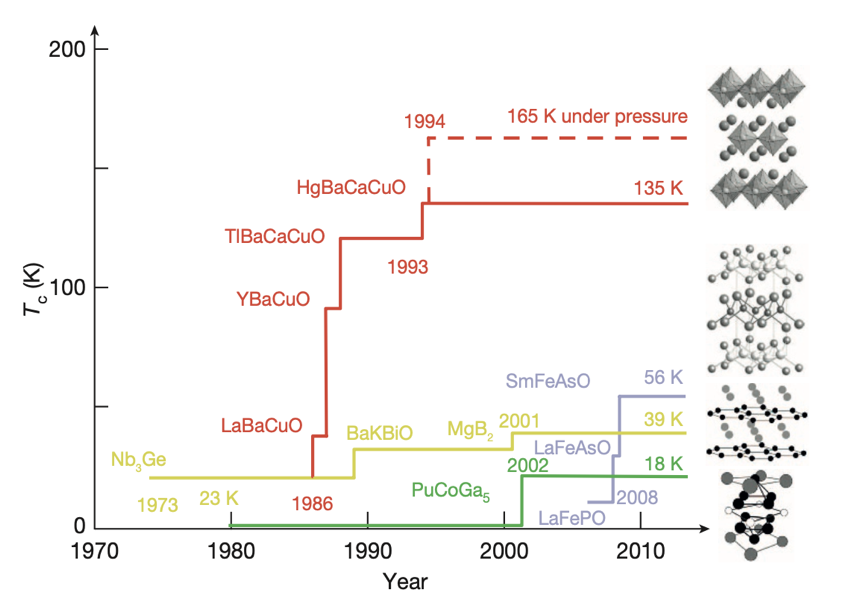
Figure 3. The discovery time and transition temperature of different superconductors, where red indicates cuprate superconductors, yellow indicates electron-phonon superconductors, green indicates heavy fermion superconductors, and purple indicates iron-based superconductors. [3]
The evolution of superconductor research has been significant, especially in the latter half of the 20th century, marked by advancements in Type II superconductors. This progress can be segmented into three distinct eras based on the types and discovery timelines of superconductors: the cuprate superconductor era, the electron-phonon and heavy fermion superconductor era, and the iron-based superconductor era. Accompanying illustrations detail the specific structures of these superconductors, visually demonstrating their unique features. This chronological categorization underscores the developmental trajectory in superconductor research, highlighting the variety and respective stages of evolution of different superconductor types.
2.1. Era of cuprate high-temperature superconductors
In 1986, a landmark discovery by the Swiss IBM research team introduced a high-temperature superconductor primarily made of copper and oxygen, notable for its layered copper-oxygen structure. Between 1980 and 2000, various cuprate superconductors were discovered and thoroughly studied, often exhibiting electronic states with d-wave symmetry. The microscopic mechanisms and theoretical understanding of these high-temperature superconductors remain a focus of intense research and discussion, with current evidence favoring the electron spin fluctuation model.
The chart's red section highlights the discovery timelines and transition temperatures of key cuprate superconductors. The first reported cuprate, L-B-C-O, had a lower transition temperature compared to later discoveries like HBCO (mercury-based superconductor), but was initially the highest known. Subsequent discoveries, such as YBCO, showed structural similarities to L-B-C-O, particularly the presence of CuO2 planes, crucial for high-temperature superconductivity. L-B-C-O achieves superconductivity by substituting La with Ba to alter its electronic state, while YBCO uses oxygen doping for carrier concentration control, illustrating different methods for inducing superconductivity in these materials.
2.2. Electro-phonon and heavy fermion superconductor era
Between the late 1880s and early 2000s, researchers discovered various superconductors based on electron-phonon and heavy fermion mechanisms. Electron-phonon superconductors, a traditional type, fundamentally depend on electron-phonon interactions crucial for electron pairing and lossless electron flow. Conversely, heavy fermion superconductors, characterized by a markedly increased effective electron mass, arise mainly from electron-electron interactions [4]. These interactions, though rare in conventional superconductors, are essential in heavy fermion superconductors.
Despite the illustration indicating that the transition temperature of PuCoGa5, a heavy fermion superconductor, is lower than other superconductors, its relatively low Fermi energy makes this temperature significantly higher in practical terms. Fermi energy plays a vital role in determining the stability and response properties of superconductors, thus being a key factor in their behavior and potential applications.
2.3. The era of iron-based superconductors
The advent of iron-based superconductors around 2010 rapidly captured the scientific community's interest. These superconductors are typically doped with elements like Lanthanum, Phosphorus, Arsenic, and Samarium. This period also witnessed significant advancements in computer technology and materials simulations, accelerating the prediction and discovery of new materials, thereby streamlining the exploration and validation of new superconductors.
While iron-based superconductors may not have a clear advantage in transition temperature over later-discovered cuprate superconductors, they possess unique physical properties with substantial research and application value. Notably, incorporating iron, traditionally considered incompatible with superconductivity due to its magnetic nature, represented a breakthrough, generating considerable scientific interest. This era saw increased research funding, with universities and institutions launching iron-based superconductor projects. Additionally, conferences and workshops on this topic emerged globally, promoting the exchange and dissemination of the latest findings. Part 4 of the article will provide an in-depth performance characterization of iron-based superconductors, examining their distinct features and potential impact on future research and applications.
2.4. Increase in superconducting transition temperature (mechanism and strategy)
The discovery of new superconductors has been propelled by a deep understanding of the mechanisms behind superconducting transition temperatures. Researchers have focused on elevating these temperatures through two primary approaches: modifying external conditions and altering the material's internal structure. Varied materials respond uniquely to these strategies, with many teams successfully increasing transition temperatures.
Superconducting phases are influenced by transition temperature, carrier density, and critical field. Adjusting carrier density and critical field has been explored to raise transition temperatures, though this method faces limitations and requires precise experimental conditions. External stress, like pressure, is also critical, as it can reduce lattice vibrations and facilitate the formation and stability of Cooper pairs, crucial for electron flow in superconductors [1].
Key strategies include modifying the crystal structure and doping to induce superconductivity. In copper oxide superconductors, for example, oxygen content significantly affects superconducting properties. Various doping techniques are employed to optimize this effect, such as Mizuguchi's 2010 study showing that oxygen annealing of Fe-Te-S samples at different temperatures can optimize superconducting characteristics, including achieving higher transition temperatures [5]. Doping also enhances electron-phonon interactions and disrupts symmetry, potentially leading to unconventional superconducting behaviors, as seen in the variable transition temperatures of YBCO high-temperature superconductors when doped with different oxides [6].
3. Research on the mechanism of high-temperature superconductivity
Theoretical research into high-temperature superconductivity is currently in a formative stage, without a consensus on a unified theory. Unraveling its complexities necessitates both experimental and theoretical research. This section intends to offer an extensive discourse on the theoretical landscape, recent progress, prevailing issues, and challenges in this domain. It will illuminate the persistent endeavors to enhance our grasp of high-temperature superconductivity and the progress towards an integrated theoretical framework.
3.1. Common theoretical models
Regarding the mechanism of high-temperature superconductivity, there are currently 7 main theoretical models:

Figure 4. Schematic diagram and momentum diffusion relationship diagram of superconductors. Figure 4a: Electron attractions are shown. Figure 4b: The relationship between transition temperature tc, frequency fluctuation t0 and different momentum diffusion tA [7].
3.1.1. BCS theory. The BCS theory, developed in 1957 by Bardeen, Cooper, and Schrieffer, successfully explains traditional superconductors. It posits that electrons, upon entering a material, interact with phonons to form Cooper pairs, enabling energy-loss-free movement in the superconducting state. This pairing results from a transient increase in cation density due to electron movement, as illustrated in Figure a, facilitating electron attraction and Cooper pair formation [8].
Electrons, as fermions, are governed by the Pauli Exclusion Principle, which precludes identical quantum states for two electrons. However, Cooper pairs, comprising electrons with opposite spins and momentum, behave like bosons, allowing them to occupy the lowest energy state and lower the system's energy. The stability of Cooper pairs is temperature-sensitive; high temperatures can disrupt them, limiting conventional superconductors to extremely low temperatures.
While effective for traditional superconductors, BCS theory struggles with high-temperature superconductors, especially cuprates. Cuprates exhibit d-wave symmetry, contrasting BCS's s-wave symmetry prediction, and display the pseudogap phenomenon at temperatures above their critical point, unexplained by BCS theory. Also, cuprate superconductors' strong electron-electron interactions and doping-dependent properties challenge BCS theory's applicability. These limitations suggest the need for theory modifications or new theories for a comprehensive explanation of high-temperature superconductors.
Despite its value, BCS theory's limitations in explaining certain high-temperature superconductors, like the d-wave symmetry in cuprates and the pseudogap phenomenon, highlight the necessity for broader theoretical frameworks. This need drives ongoing research for more inclusive superconductivity theories, a crucial endeavor in the superconductivity field.
3.1.2. Spin fluctuation model, representative theories include resonating-valence-bond theory, etc.. Spin Fluctuation (SF) or SCR theory focuses on antiferromagnetic interactions within copper-oxygen planes, suggesting superconducting pairing arises from electron spin fluctuations. Developed to explain superconductivity in cuprates under strong electron-electron interactions and antiferromagnetic correlations, it proposes d-wave or odd-parity p-wave pairing, aligning with experimental observations in cuprates, thereby affirming its relevance [9-11].
Cuprate superconductors' mechanism is markedly different from traditional superconductors. Key to cuprates is strong electron interaction. Unlike typical electron repulsion that impedes pairing, in cuprates near the antiferromagnetic phase transition, electron spins fluctuate significantly. These fluctuations induce an effective attraction, enabling Cooper pair formation, diverging from BCS theory’s phonon-mediated process. The figure demonstrates the relationship between frequency fluctuations, momentum diffusion, and transition temperature, showing lower transition temperatures with decreasing momentum diffusion or frequency fluctuations [12], illustrating the complex interplay of these factors in cuprate superconductivity.
SF or SCR theory provides substantial insights into cuprate superconductors' microscopic mechanisms, yet some aspects remain unexplained. Ongoing experimental and theoretical research is expected to enhance our understanding, potentially leading to novel superconducting technologies and applications. This continuous research is essential to expand our knowledge and advance superconducting technology.
3.1.3. Resonating Valence Bond theory. RVB (Resonating Valence Bond) theory provides a novel perspective on superconductivity, positing that strong electron interactions in undoped materials create a Mott insulating state with antiferromagnetic properties and non-conductivity. Upon doping, either by adding electrons or holes, this antiferromagnetic order is disrupted, transforming the material from insulating to superconducting. RVB theory elucidates how doping-induced alterations in electron interactions can change a material’s conductive state.
This theory introduces a distinct electron pairing mechanism, where electron pairs resonate or 'jump' across broad crystal areas, contrasting with BCS theory’s Cooper pairing dependent on phonon-electron interactions. RVB pairing arises from intense electron correlation and antiferromagnetic interaction, leading to a fluid, non-conventional superconducting state with unique behaviors tied to superconducting phenomena.
RVB theory explains d-wave pairing symmetry observed in cuprate superconductors, distinct from conventional superconductors' s-wave pairing. It also addresses the pseudogap phenomenon, an energy gap in the electronic state above the superconducting critical temperature, unexplained by BCS theory but compatible with RVB's explanation of strong electron correlation and non-local pairing, contributing to atypical electronic states above the superconducting phase transition.
3.1.4. Fermi surface theory, which believes that superconductivity originates from the reconstruction of electronic states near the Hermitian surface. Representatives include Van Hove Singularity theory and so on. Fermi surface theory is vital in comprehending the doping effects in high-temperature superconductors. The Fermi surface, a concept in momentum space (k space), defines a surface where electron energy equals the highest energy level at absolute zero. Doping alters the electronic structure and thus the Fermi surface, impacting superconductivity by either facilitating or hindering electron pairing. The electronic density of states, the number of electron energy states per unit energy, plays a critical role; a high density near the Fermi level aids Cooper pair formation, while a low density impedes it. Superconductors like YBCO, displaying variable properties upon doping, are not fully explicable by BCS theory, but Fermi surface theory potentially explains these changes by considering doping’s effects on electronic structure and the Fermi surface.
High-temperature superconductors typically exhibit d-wave pairing, distinct from the s-wave pairing of traditional superconductors, indicating that Cooper pairs in these superconductors are affected by electron momentum direction, with stronger interactions in certain directions. The concept of nesting on the Fermi surface sheds light on this pairing. When the Fermi surface shifts by a specific vector in k space, it can result in overlapping surfaces, creating a unique nesting relationship. This configuration facilitates interactions between electrons on these surfaces with others or phonons. Analyzing the Fermi surface is therefore essential for unraveling high-temperature superconductors’ mechanisms, revealing how electron momentum directionality and spatial relationships within the Fermi surface affect their superconductivity. Such exploration is fundamental to enhancing our understanding of high-temperature superconductors’ intricate behaviors and properties.
3.1.5. Charge density wave theory, superconductivity is related to charge density waves in the cupro-oxide plane, represented by stripes theory, etc.. Charge Density Wave (CDW) theory explains certain superconductors' properties, positing that materials exhibit periodic charge density variations due to lattice vibrations. These modulations, sometimes aligning with copper bonds to form stripe-like patterns, reveal a dynamic interaction between lattice structure and charge distribution, shedding light on superconductors' complex behaviors.
In some cases, conditions favorable for CDW formation might inhibit superconductivity, with CDWs forming between electrons instead of Cooper pairs. However, CDWs and superconductivity can coexist, possibly leading to novel phenomena. In such scenarios, CDWs’ periodic nature might even aid Cooper pair formation. By manipulating CDWs, researchers can modify superconductors' properties, emphasizing the interplay between CDWs and superconductivity.
This theory, still in development, does not fully explain all superconductor behaviors. The CDWs-superconductivity relationship represents a complex, evolving area of study, indicative of the continuous advancement and refinement of theories in this domain.
3.1.6. Electronic phase relationship theory, starting from the overall interaction of the electronic system, the superconducting phase is one of the ordered phases. Viewing superconductivity as an ordered phase offers a profound perspective in solid-state physics. Here, an ordered state signifies strong interparticle correlations within a substance, resulting in distinct properties, particularly in relation to magnetic fields. Superconductivity exemplifies this order through the coherent behavior of electron pairs (Cooper pairs), enabling electricity to flow without resistance. This interpretation of superconductivity underscores the collective and interconnected nature of particle behavior, deepening our grasp of its fundamental aspects.
Several ordered states are recognized in superconductors, including ferromagnetic, antiferromagnetic, superconducting, Charge Density Wave (CDW), and Bose-Einstein Condensate (BEC) phases. In ferromagnetism, electrons align spins in the same direction, while antiferromagnetism features opposite spins in adjacent electrons, integral to the spin fluctuation model. The superconducting phase, characterized by cohesive electron interactions forming Cooper pairs, is essential for understanding superconductivity. The CDW phase, fundamental to charge density wave theory, involves periodic electron density modulations in a material. In the BEC phase, bosonic particles at ultra-low temperatures collectively occupy the lowest energy state. These diverse phases highlight the multifaceted nature of order in superconducting and related materials, each contributing to our comprehension of their unique properties and behaviors.
3.2. Current issues and challenges
High-temperature superconductors present a challenging and intricate area of study. Despite numerous theoretical models developed since their discovery, a full grasp of their mechanisms remains elusive. Key challenges include understanding pseudogap formation, deciphering the microscopic mechanisms, and accurately predicting transition temperatures. These unresolved areas underscore the need for continued research, highlighting the depth and complexity in studying high-temperature superconductors. Ongoing research aims to close these knowledge gaps, advancing our understanding of these remarkable materials.
The pseudogap, a notable aspect in high-temperature superconductors, is an electron gap on the Fermi surface, occurring above the transition temperature and suggesting a change in the electron state before the onset of superconductivity. Navindar's findings indicate the pseudogap phase disappears at certain critical doping levels, aligning with peak transition temperatures in cuprate superconductors [13]. This link emphasizes the significance of pseudogap studies in demystifying high-temperature superconductors. Pseudogap research is vital as it offers insights into the electrons' pre-superconducting behavior, aiding in unraveling the complexities of these materials. Understanding this phenomenon is crucial for solving the puzzle of high-temperature superconductivity [13].
The precise mechanism behind high-temperature superconductors is still a major unresolved question. While Cooper pairs are crucial for electron interactions in these materials, the exact mechanism of their formation is debated. Unlike traditional superconductors where electron-phonon interactions dominate, high-temperature superconductors lack a consensus on the formation of Cooper pairs. Theories like strong electron correlation and self-selected fluctuation have been suggested, but none provide a complete explanation for all superconductor phenomena and characteristics. Additionally, varying structures in different high-temperature superconductors likely lead to diverse mechanisms, complicating the understanding of these materials.
Predicting the transition temperature of superconductors is another significant hurdle. Despite various theoretical models for high-temperature superconductors, their incompleteness impedes accurate temperature prediction. For example, Fermi surface theory aids in assessing spatial relationships for Cooper pair formation, but a comprehensive prediction of transition temperatures necessitates considering all influencing factors. This requires integrating multiple analytical models, a complex task due to inconsistencies among these theories. The challenge lies in accounting for numerous variables that influence transition temperature, underscoring the need for more unified and comprehensive theories in superconductivity research.
4. High temperature superconducting materials
Table 1. This table shows the characteristics of the three types of superconductors.
Properties of several types of superconductors | |
Traditional superconductor | Mainly explained by BCS theory Mainly based on electron-phonon interaction Distinct energy gap Low Tc Complete Meissner effect |
Copper oxide superconductor | Strong electron-electron interaction Muti-phase Ultra-high Tc CuO2 layer |
Iron based superconductor | Coexistence between magnetism and superconductivity FeAs layer High Tc |
The vast array of superconductors discovered to date can be broadly classified into three categories: traditional, copper oxide, and non-copper oxide superconductors, each differing in elemental properties and characteristics. Traditional superconductors, or Type I, exhibit specific low-temperature properties, while cuprate and non-copper oxide superconductors, classified as Type II, are known for high-temperature behaviors. These groups vary in properties, structural compositions, and preparation methods.
Superconductivity research achieved a milestone in 1908 with liquefied helium technology, leading to Heike Kamerlingh Onnes’ discovery of superconductivity in mercury at 4.2K in 1911. Mercury, the first traditional superconductor, was followed by other metals like Zinc and Cadmium showing superconducting properties at extremely low temperatures. The Bardeen-Cooper-Schrieffer (BCS) theory, explaining Cooper pair formation, has significantly advanced our understanding of these early superconductors.
Cuprate superconductors, including Yttrium-Barium-Copper-Oxide (YBCO) and Lanthanum-Barium-Copper-Oxide (L-B-C-O), vary in composition and structure. Doping, a method of altering electron density, is a key technique in modifying and studying the properties of these high-temperature superconductors.
Non-copper oxide superconductors, encompassing iron-based, nickel-based, and elemental superconductors, saw a breakthrough with the discovery of carbon-based superconductors in 1994 and hydrogen sulfide (H2S) exhibiting superconductivity at 203K under high pressure in 2015. This latter finding, a significant stride towards room-temperature superconductors, illustrates the diverse mechanisms and unique properties of non-copper oxide superconductors, expanding the realm of superconductivity research and paving the way for innovative materials.
4.1. Preparation method
Traditional superconductors, including pure elements or metal alloys, are relatively simple to prepare compared to high-temperature superconductors. Elemental superconductors like mercury, typically found in compounds in nature, are extracted from mercury sulfide. The process involves condensing mercury vapor and purifying it via distillation. Pure metallic elemental superconductors are often cast into experimental shapes. Alloy-based traditional superconductors are created using high-temperature smelting for thorough metal mixing. Thin films of these metals are commonly made through Physical Vapor Deposition (PVD), where the material is heated, evaporated, and condensed into thin films. These methods are crucial for traditional superconductors' preparation and application in various settings.
Cuprate superconductors like YBCO require more complex preparation methods. Solid-state reaction techniques are typical for YBCO, involving mixing yttrium oxide, barium carbonate, and copper oxide, grinding, and sintering at around 1,000 degrees Celsius. Laser Pulse Deposition is used for thin films, where a laser vaporizes the material for deposition onto a substrate. The methods for LBCO and iron-based superconductors are similar but vary in raw materials. Each cuprate superconductor needs specific processing to achieve desired superconducting properties, underlining their complex production nature.
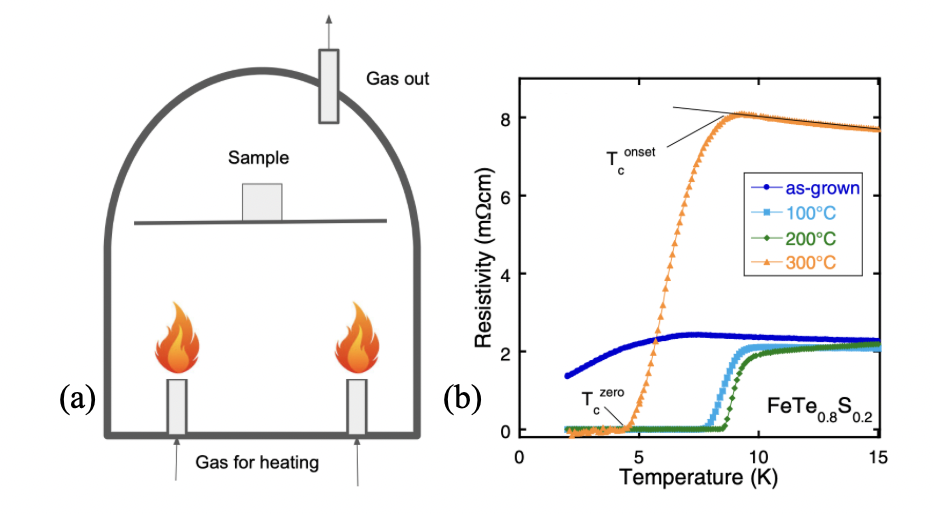
Figure 5. Fabrication of oxide high-temperature superconductor and temperature-resistance curve. Figure 5a (left): Preparation of copper oxide high-temperature superconductors using sintering treatment; Figure 5b (right): Temperature-resistance curves of FeTe0.8S0.2 samples at different annealing temperatures [14].
Compound superconductors' properties, particularly their superconducting phase and transition temperatures, are significantly influenced by specific oxygen doping levels achieved through annealing in oxygen-rich environments. The annealing process markedly impacts these superconductors' physical attributes. Mizuguchi's research on FeTe0.8S0.2, exposed to varying annealing temperatures, exemplifies this. His findings revealed that different annealing temperatures altered the material's transition temperature. A notable increase in transition temperature was observed when the sample underwent annealing at 200 degrees Celsius, as shown in the referenced figure [5]. This demonstrates the crucial role of annealing conditions in defining the superconducting properties of compound superconductors and illustrates how environmental control can effectively modify and enhance their superconducting capabilities.
4.2. Performance Characterization
The Meissner effect presents distinct behaviors in traditional versus high-temperature superconductors. Traditional superconductors, like mercury, fully repel external magnetic fields below their transition temperature, with fields barely penetrating their surface. In contrast, high-temperature superconductors, including copper oxide and non-copper oxide varieties, show partial field repulsion within a specific temperature window, between their lower and upper critical temperatures. The upcoming article will thoroughly explore these categories' physical properties, elucidating their unique responses to magnetic fields and temperature variations.
Table 2. The table shows the transition temperatures of elemental superconductors. Among them, Nb and V are type II superconductors, and the rest are basically traditional superconductors.
Element | Critical temperature (K) | Element | Critical temperature (K) |
Aluminum | 1.13–1.197 | Tin | 3.702–3.752 |
Titanium | 0.387–0.56 | Lanthanum | 4.2–5.4–6.0 |
Vanadium | 4.69–4.89–5.13 | Hafnium | 0.37 |
Zinc | 0.84–0.905–0.96 | Tantalum | 4.06–4.38–4.5 |
Gallium | 1.06–1.103 | Rhenium | 0.9–1.699–2.42 |
Zirconium | 0.546–0.70 | Osmium | 0.71 |
Niobium | 8.35–8.70–8.85 | Mercury | 4.150–4.173 |
Technetium | 11.2 | Thallium | 2.36–2.392 |
Ruthenium | 0.47 | Lead | 7.2 |
Cadmium | 0.54–0.560–0.65 | Thorium | 1.37 |
Indium | 3.37–3.396–3.40 | Uranium | 0.8–1.3 |
Conventional superconductors, while fully diamagnetic in their superconducting phase, have relatively low transition temperatures, typically below 30K. Niobium (Nb) and Vanadium (V), as shown in the accompanying figure, are Type II superconductors. Recent discoveries have identified traditional superconductors with higher critical temperatures (Tc), and some materials exhibit superconducting properties under high pressure or in thin-film states. However, achieving superconductivity in these materials often requires strict conditions, limiting their practical use. Structurally, traditional superconductors are characterized by simple metal lattices, such as face-centered cubic arrangements, contrasting the complex layered structures of high-temperature superconductors, underscoring the intrinsic differences between these two superconductor categories.
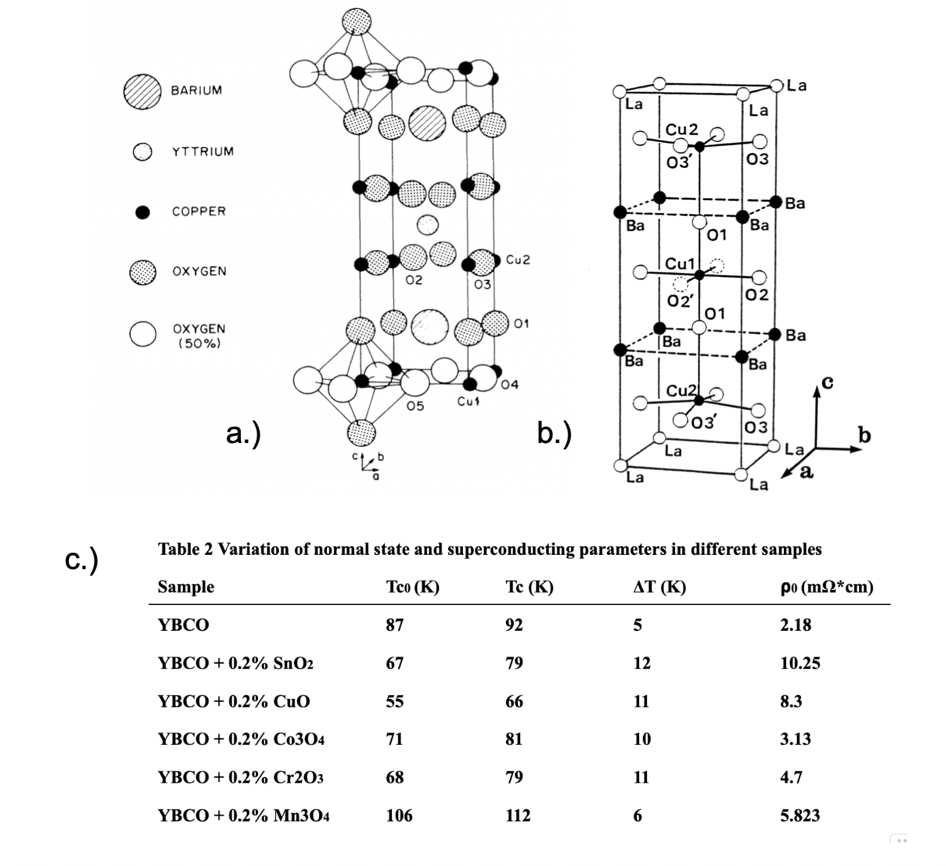
Figure 6. Lattice structure diagram of high-temperature superconductor. Figure 6a (left): Crystal structure diagram of YBCO high-temperature superconductor [14]; Figure 6b (right): Crystal structure diagram of LBCO high-temperature superconductor [15].
Copper oxide superconductors, particularly YBCO (Yttrium Barium Copper Oxide) and L-B-C-O (Lanthanum Barium Copper Oxide), are central to high-temperature superconductivity research. Bednorz and Müller's 1986 discovery at the IBM Research Institute in Switzerland marked a milestone, finding La-Ba-Cu-O with a superconducting transition temperature of 30K, significantly advancing high-temperature superconductivity studies. A key trait of these superconductors is their increasing transition temperature under high pressure [16], offering valuable insights for enhancing their superconducting capabilities. Structurally, Yoshizaki’s crystal structure diagram for LaBa2Cu3-xOy, derived from Powder X-ray Diffraction measurements [15], elucidates the atomic arrangement and lattice structure of cuprate superconductors, deepening our understanding of their superconducting mechanisms and properties. Such structural investigations are vital for progressing high-temperature superconductivity research.
Table 3. Resistance of YBCO doped with different compounds, where the resistance is calculated from the temperature-resistance curve [6].
Variation of normal state and superconducting parameters in different samples | ||||
Sample | Tc0 (K) | Tc (K) | ΔT (K) | ⍴0 (mΩ⋅cm) |
YBCO | 87 | 92 | 5 | 2.18 |
YBCO + 0.2% SnO2 | 67 | 79 | 12 | 10.25 |
YBCO + 0.2% CuO | 55 | 66 | 11 | 8.3 |
YBCO + 0.2%Co3O4 | 71 | 81 | 10 | 3.13 |
YBCO + 0.2% Cr2O3 | 68 | 79 | 11 | 4.7 |
YBCO + 0.2% Mn3O4 | 106 | 112 | 6 | 5.823 |
YBCO cuprate superconductors are highly researched for their high transition temperatures, typically around 90 K, which can be further increased through doping. Salama's 2015 study demonstrated that doping with manganese oxide, for instance, raised the transition temperature to 112K [6], enhancing their practical utility. Initially, YBCO superconductors had limitations with magnetic fields and current flow, but these were overcome in 1988 with the Melt-texture-growth sintering method [17]. Structurally, YBa2Cu3O7-* superconductors, characterized by two CuO2 planes, are conducive to superconductivity [14]. In 1988, Maeda's discovery of the Bi-Sr-Ca-Cu-O system reaching nearly 120K transition temperatures expanded high-temperature superconductors' practical applications.
Non-copper oxide high-temperature superconductors, including elemental and iron-based types, vary significantly from cuprate superconductors. Elemental Type II superconductors like Niobium (Nb) and Vanadium (V) have lower transition temperatures—8.85K and 5.13K, respectively—compared to cuprates. Their structure is relatively simple, often a single-element crystal lattice, contrasting the complex, layered structures of copper oxide superconductors. The superconducting mechanism in elemental Type II superconductors, primarily electron-phonon interactions, is well understood, unlike the less clear mechanisms in cuprate superconductors.
The 2006 discovery of iron-based La-O-Fe-P superconductors with a 4K transition temperature [18] and the 2008 discovery of La-O-F-Fe-As with a 26K transition temperature [19] marked significant progress in superconductor research. These iron-based superconductors, distinct in composition from CuO2-based superconductors, often have lower transition temperatures than cuprates. For example, SmFeAsO1-x exhibits a transition temperature of 55K, below the 90K of YBCO cuprates. Nickel-based superconductors, as potentially shown in Figure 8a, share structural similarities with iron-based types, suggesting possible parallels in their superconducting mechanisms and behaviors. This structural resemblance enhances our understanding of high-temperature superconductivity across different superconductor families.
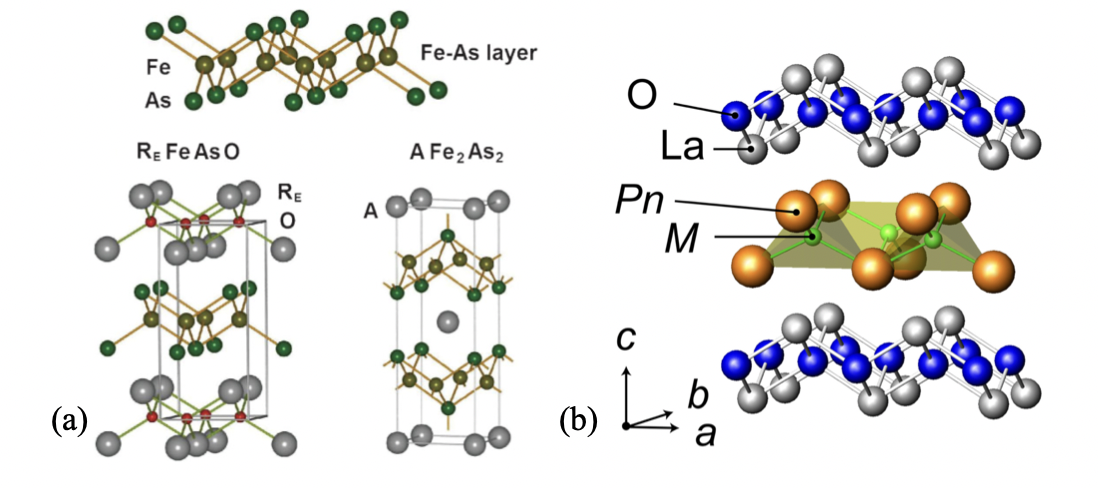
Figure 7. Structural diagram at the high-temperature superconductor level. Figure 7a: Fe-As layer, crystal structure diagram of two different iron-based superconductors [20]; Figure 7b: Mechanism of nickel-based superconductor and the M-Pn layer that plays a key role [21].
5. Application of high-temperature superconducting technology
5.1. Magnet
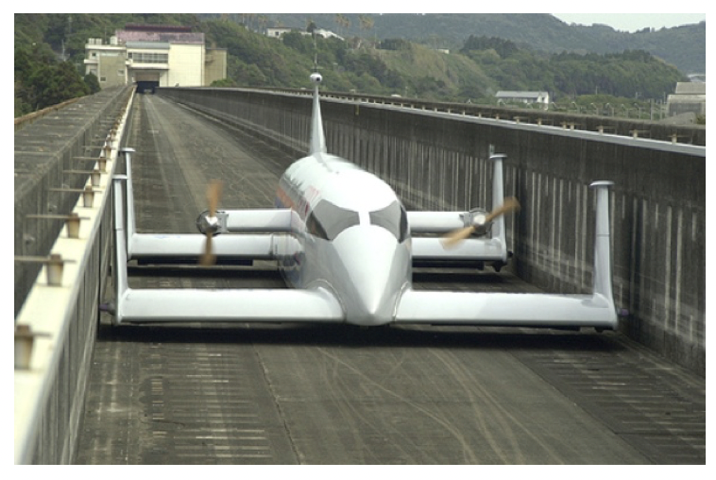
Figure 8. Test model of maglev train [22].
High-temperature superconductors have revolutionized electromagnet technology, offering several advantages over conventional electromagnets. These include greater current capacity, enhanced stability, the ability to generate stronger magnetic fields, and higher energy efficiency. Notably, they require lower cooling temperatures, making them more practical in various technological and industrial applications.
Ampere's Law, which describes the magnetic field around a current-carrying conductor, laid the foundation for electromagnet development. Traditional electromagnets, often using iron or alloys as conductors, face limitations due to inherent resistance and heat generation under high current loads. In contrast, superconductors, with zero resistance, can carry stronger currents, enabling the creation of more powerful magnets. This property is invaluable in applications requiring intense magnetic fields, like MRI machines and particle accelerators, enhancing their efficiency and performance.
Electromagnets are generally of two types: DC and AC. Both require continuous current due to resistance in conducting materials. However, superconducting electromagnets, devoid of electrical resistance, maintain current flow without additional input. Once activated, a current in a ring-shaped superconductor can circulate indefinitely. This enduring stability is crucial in magnetic scanning devices like NMR Spectroscopy, allowing for more accurate data collection. High-temperature superconductors are also pivotal in magnetic levitation (maglev) trains, maintaining strong, consistent magnetic fields without ongoing energy input, surpassing traditional electromagnet technologies in efficiency and performance.
5.2. Power equipment
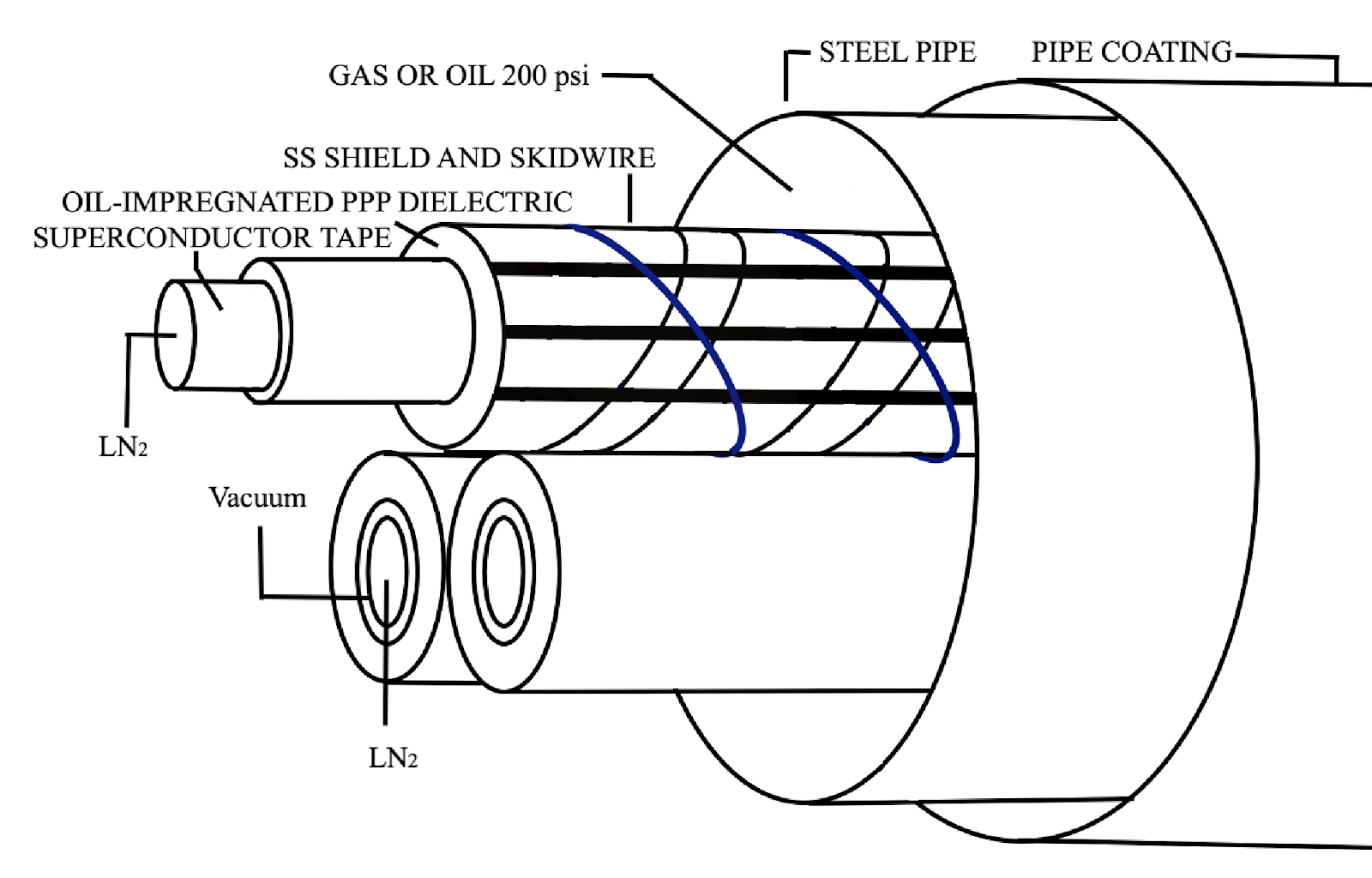
Figure 9. Structural diagram of a superconductor wire with high-temperature superconductor tape as the core [1].
High-temperature superconductors provide promising applications in power equipment like power transmission systems, microwave filters, and superconducting analog-to-digital converters, offering superior stability and energy transfer efficiency over traditional semiconductor devices. Yet, their practical use faces challenges, such as the need for low-temperature maintenance requiring complex cooling systems, material strength issues, and high maintenance costs. These challenges highlight the necessity for ongoing research to enhance the real-world applicability of high-temperature superconductors.
Conventional high-voltage cables, the standard for electricity transmission, minimize power loss by reducing current and increasing voltage. However, the inherent resistance in these cables leads to heating issues and energy loss. Superconducting cables, with zero resistance, provide an efficient alternative. As depicted in Figure 10, these cables incorporate peripheral gas and oil for protection and as part of the necessary environment for high-temperature superconductors. They are ideal for applications requiring efficient electrical energy transmission and space constraints. Superconducting cables offer maximized efficiency and performance, surpassing traditional conductor cables' limitations.
Superconducting filters, utilized for selective frequency signal transmission, offer distinct advantages over traditional material filters, including lower energy loss and a higher Q value, indicative of broader bandwidth and minimized loss. These features are crucial for preserving signal integrity. Despite the challenging external conditions required, such as low temperatures and high pressure, superconducting filters are highly promising in scientific research for their exceptional data accuracy. Their enhanced performance is particularly beneficial in fields requiring precise signal filtration and minimal interference. In the realm of analog-to-digital conversion, which entails transforming continuous signals into discrete digital formats, superconducting converters excel by providing high-precision signals with significantly low signal-to-noise ratios, attributed to their zero-resistance quality. This precision is vital in high-accuracy scientific research and other applications where signal fidelity is paramount. The unique capabilities of superconductors in these contexts highlight their importance and potential to elevate technological advancements across various disciplines.
5.3. Quantum information
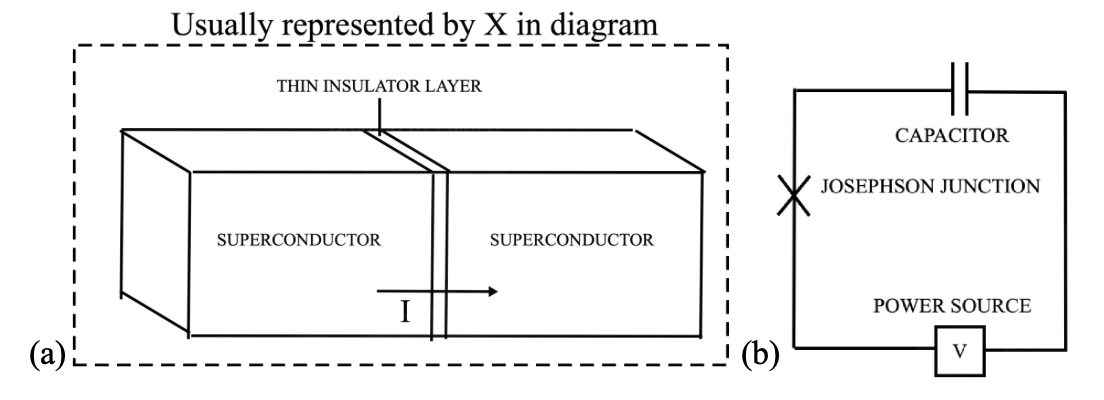
Figure 10. Principles and applications of Josephson knot. Figure 11a: Simplified structural diagram of the Josephson junction. Figure 11b: Charge qubits composed of the Josephson junction, the basic information processing and storage of quantum computers’ unit.
The quantum information field, encompassing quantum communication and computing, is nascent yet rapidly evolving. Quantum communication promises groundbreaking advancements in encryption, ensuring secure data transmission crucial for safeguarding sensitive information. Quantum computing, surpassing traditional computing, offers unmatched efficiency and the ability to solve currently intractable problems, thereby revolutionizing scientific research.
In quantum communications, storing information is crucial. Superconductors excel as materials for quantum memory devices, with their quantum memories acting as repeaters for long-distance quantum information transmission. This enhances quantum communication networks' reach and reliability. Moreover, superconducting nanowire single-photon detectors surpass traditional detectors in accuracy and response time, vital for precise quantum information conversion, like from photons to microwaves, ensuring the integrity of quantum data.
Superconductors are pivotal in quantum computing. Figure 9 may illustrate how a Josephson junction, formed by two superconductors separated by an insulator, enables electron pairs to tunnel through, even without a current. The junction's magnetic flux quantization facilitates qubit functionality, essential for quantum computing. Qubits, unlike binary bits, exist in multiple states simultaneously, exponentially increasing a quantum computer's processing capability. Integrating superconductors into quantum computing not only elevates their functionality but also potentially surpasses traditional computing, marking a significant advancement in computational technology.
5.4. Other applications
High-temperature superconductors are increasingly employed in motor manufacturing, applicable to various motor types including synchronous motors, homopolar DC motors, induction synchronous motors, and claw-pole DC motors. Synchronous motors have been extensively studied. These motors operate coordinated with the power supply frequency, providing greater stability and precision than asynchronous motors. In high-temperature superconducting synchronous motors, the rotor is composed of superconducting coils, with an exciter generating a magnetic field to rotate the rotor.
A primary benefit of using high-temperature superconductors in motors is their zero-resistance feature, eliminating Joule heating in direct current transport and significantly boosting motor efficiency, even considering the energy required for cooling. However, these superconductors need a relatively low-temperature environment, necessitating stable and efficient cooling systems. Despite this, the overall advantages, particularly in energy efficiency, position high-temperature superconductor motors as a promising advancement in motor technology.
6. Challenge and prospects
6.1. Current main issues
Despite significant advancements in superconductors, unresolved challenges persist. The absence of a unified theory explaining superconductivity's microscopic mechanism and controversies over identifying superconductors are key issues. Practical applications also face numerous unresolved challenges.
The BCS theory, while successful for traditional superconductors, lacks a comprehensive model for unconventional superconductors. Alternative theories, such as strong electron correlation and magnetic field oscillation, offer partial explanations but lack universality. Moreover, the exotic metallic phases in cuprate superconductors still require a complete theoretical explanation.
The identification of superconducting materials typically relies on two criteria: zero resistance and the Meissner effect. The I-V scaling method, commonly used for high-temperature superconductors, may not fully confirm a superconductor's state. Strachan argues that some materials, like YBCO, exhibit near-zero resistance, challenging the zero-resistance criterion. Furthermore, high-temperature superconductors' partial magnetic field repulsion and intrinsic magnetism in some materials complicate assessments based on the Meissner effect, indicating a need for more refined evaluation methods [23].
Most high-temperature superconductors require liquid nitrogen cooling, adding significant costs and practicality challenges. Furthermore, superconducting cables and other applications depend on consistent superconducting phase maintenance. Any shift to a normal phase can lead to heat generation and device failure. Additionally, many high-temperature superconductors are ceramic-based, making them fragile and prone to damage. These physical limitations, alongside the need for optimal operational conditions, make widespread application of high-temperature superconductors challenging.
6.2. Future development direction
Superconductors, epitomizing a fusion of modern physics and materials science, have captivated global scientific interest. Known for their zero resistance, they offer immense potential and pose significant challenges in theoretical understanding, material innovation, and practical application. As scientific understanding and technology evolve, superconductivity is moving towards more practical and widespread uses, navigating constraints of existing theories like the BCS model, environmental requirements for operation, and hurdles in practical deployment. This evolution exemplifies a dynamic field, constantly pushing the limits of what is possible in this complex domain.
Theoretically, the BCS theory stands as the most comprehensive model for superconductivity but is limited in explaining various phenomena. Alternative models seek to fill these gaps, but a unified, integrative theory is yet to emerge. Anticipated future research aims to develop a model that not only aligns with existing theories but also offers a comprehensive framework. Understanding the mechanisms and principles of high-temperature superconductors is crucial for foundational advancements in the field.
High-temperature superconductors' reliance on extreme environmental conditions poses practical application challenges. Future research focuses on creating new synthesis strategies for superconductors that function in more conventional conditions, potentially at room temperature and standard pressure. Such breakthroughs could greatly expand high-temperature superconducting technology applications.
Practical application of superconducting technology currently faces obstacles like excessive costs and large equipment sizes, limiting broader use. However, ongoing research holds promise for new processing and manufacturing techniques, potentially optimizing size and cost, thereby enhancing accessibility. These advancements could revolutionize fields such as communications, computing, and sensing, with superconductors enhancing data transmission efficiency, computing power and speed (especially in quantum computers), and instrument sensitivity and accuracy. Integrating superconducting technology into these areas would mark a significant stride towards incorporating this advanced technology into everyday life, heralding transformative benefits and new opportunities.
7. Conclusion
Since its inception in the 20th century, the field of superconductors has undergone extensive development over a century. The unique properties of superconductors, notably zero resistance and diamagnetism, starkly contrasting with ordinary metals, have continuously intrigued researchers. The journey began with traditional superconductors, evolved to cuprate superconductors, and then to non-copper oxide superconductors. With each new material discovered, our understanding of superconductors has been deepened.
Initially, the BCS theory, focusing on electron-phonon interaction, provided a foundational understanding. It was later complemented by theories addressing strong electron correlation, among others. However, as the field of superconductors expands, new phenomena such as pseudogaps have been observed, challenging traditional theoretical frameworks. Researchers also critically reassess data from completed superconductor experiments, reflecting the dynamic nature of this field.
Despite these challenges, ongoing research in superconductors continues to fuel optimism about their potential to revolutionize technology and improve everyday life. This review paper aims to offer a comprehensive overview for newcomers to the field and to spark further inquiry and inspiration among researchers, contributing to the ever-evolving landscape of superconductor science.
References
[1]. A. Bourdillon and N. X. Tan Bourdillon 1994 High Temperature Superconductors: Processing and Science ACADEMIC PRESS LIMITED (London/United Kingdom)
[2]. Nie, Y. F., Telesca, D., Budnick, J. I., Sinkovic, B. and Wells, B. O. Jul. 2010 Superconductivity induced in iron telluride films by low-temperature oxygen incorporation. 82 American Physical Society 020508
[3]. B. Keimer, S. A. Kivelson, M. R. Norman, S. Uchida and J. Zaanen 2015 From quantum matter to high-temperature superconductivity in copper oxides 518 Nature 179-186
[4]. G. R. Stewart Oct. 1984 Heavy Fermion Systems 56 American Physical Society 755-787
[5]. Y. Mizuguchi, K. Deguchi, S. Tsuda, T. Yamaguchi and Y. Takano 2010 Evolution of Superconductivity by Oxygen Annealing in FeTe0.8S0.2 90 EPL 57002
[6]. A H Salama, M EI-Hofy, Y S Rammah and M Elkhatib 2015 Effect of magnetic and nonmagnetic nano metal oxides doping on the critical temperature of a YBCO superconductor 6 Advances in Natural Sciences: Nanoscience and Nanotechnology 045013
[7]. J. Orenstein and A. J. Millis 2000 Advances in the Physics of High-Temperature Superconductivity 288 Science 468-474
[8]. J. Bardeen, L. N. Cooper, and J. R. Schrieffer 1957 Theory of superconductivity 108 American Physical Society 1175
[9]. Anthony J. Leggett April 1975 A theoretical description of the new phases of liquid 3He 47 American Physical Society 331
[10]. K. Miyake, S. Schmitt-Rink and C.M. Varma November 1986 Spin-fluctuation-mediated even-parity pairing in heavy-fermion superconductors 34 Physical Review B 6554-6556
[11]. D. J. Scalapino, E. Loh, Jr. And J. E. Hirsch December 1986 d-wave pairing near a spin-density-wave instability 34 Physics Review B 8190-8192
[12]. Moriya, Tôru, and Kazuo Ueda 2000 Spin fluctuations and high temperature superconductivity 49 Advances in Physics 555-606
[13]. Navinder Singh 2021 Leading theories of the cuprate superconductivity: A Critique 580 Physica C: Superconductivity and its Applications 1353782
[14]. T. Siegrist, S. Sunshine, D. W. Murphy, R. J. Cava, and S. M. Zahurak 1987 Crystal structure of the high-Tc superconductor Ba2YCu3O9−δ 35 Physical Review B 7137
[15]. Ryozo Yoshizaki, Hideaki Sawada, Toshiaki Iwazumi, Yosuke Saito, Yoshihito Abe, Hiroshi Ikeda, Katsuhiro Imai and Izumi Nakai 1987 Superconductivity and Crystal Structure of LaBa2Cu3-xOy Compounds 26 Japanese Journal of Applied Physics L1703
[16]. C. W. Chu, P.H. Hor, R. L. Meng, L. Gao, and Z. J. Huang 1987 Superconductivity at 52.5 K in the lanthanum-barium-copper-oxide system 235 Science 567-569
[17]. S. Jin, T. H. Tiefel, R. C. Sherwood, M. E. Davis, R. B. van Dover, G. W. Kammlott, R. A. Fastnacht and H. D. Keith 1988 High critical currents in Y‐Ba‐Cu‐O superconductors 52 Applied Physics Letters 2074–2076
[18]. Yoichi Kamihara, Hidenori Hiramatsu, Masahiro Hirano, Ryuto Kawamura, Hiroshi Yanagi, Toshio Kamiya and Hideo Hosono 2006 Iron-Based Layered Superconductor: LaOFeP 128 American Chemical Society 10012-10013
[19]. Yoichi Kamihara, Takumi Watanabe, Masahiro Hirano, and Hideo Hosono 2008 La [O1-XFX]FeAs (x=0.05-0.12) with TC=26K 130 Journal of the American Chemical Society 3296-3297
[20]. Zhi-An Ren, Zhong-Xian Zhao 2009 Research and Prospects of Iron-Based Superconductors 21 Advanced Materials 4584-4592
[21]. T. Watanabe, H. Yanagi, Y. Kamihara, T. Kamiya, M. Hirano and H. Hosono 2008 Nickel-based layered superconductor, LaNiOAs 181 Journal of Solid State Chemistry 2117-2120
[22]. Yaghoubi H. Practical applications of magnetic levitation technology Iran Maglev Technology (IMT) 1-56
[23]. Douglas R. Strachan, Matthew C. Sullivan and Christopher J. Lobb 2002 Probing the limits of superconductivity SPIE
Cite this article
Wu,H. (2024). Recent development in high temperature superconductor: Principle, materials, and applications. Applied and Computational Engineering,63,153-171.
Data availability
The datasets used and/or analyzed during the current study will be available from the authors upon reasonable request.
Disclaimer/Publisher's Note
The statements, opinions and data contained in all publications are solely those of the individual author(s) and contributor(s) and not of EWA Publishing and/or the editor(s). EWA Publishing and/or the editor(s) disclaim responsibility for any injury to people or property resulting from any ideas, methods, instructions or products referred to in the content.
About volume
Volume title: Proceedings of the 4th International Conference on Materials Chemistry and Environmental Engineering
© 2024 by the author(s). Licensee EWA Publishing, Oxford, UK. This article is an open access article distributed under the terms and
conditions of the Creative Commons Attribution (CC BY) license. Authors who
publish this series agree to the following terms:
1. Authors retain copyright and grant the series right of first publication with the work simultaneously licensed under a Creative Commons
Attribution License that allows others to share the work with an acknowledgment of the work's authorship and initial publication in this
series.
2. Authors are able to enter into separate, additional contractual arrangements for the non-exclusive distribution of the series's published
version of the work (e.g., post it to an institutional repository or publish it in a book), with an acknowledgment of its initial
publication in this series.
3. Authors are permitted and encouraged to post their work online (e.g., in institutional repositories or on their website) prior to and
during the submission process, as it can lead to productive exchanges, as well as earlier and greater citation of published work (See
Open access policy for details).
References
[1]. A. Bourdillon and N. X. Tan Bourdillon 1994 High Temperature Superconductors: Processing and Science ACADEMIC PRESS LIMITED (London/United Kingdom)
[2]. Nie, Y. F., Telesca, D., Budnick, J. I., Sinkovic, B. and Wells, B. O. Jul. 2010 Superconductivity induced in iron telluride films by low-temperature oxygen incorporation. 82 American Physical Society 020508
[3]. B. Keimer, S. A. Kivelson, M. R. Norman, S. Uchida and J. Zaanen 2015 From quantum matter to high-temperature superconductivity in copper oxides 518 Nature 179-186
[4]. G. R. Stewart Oct. 1984 Heavy Fermion Systems 56 American Physical Society 755-787
[5]. Y. Mizuguchi, K. Deguchi, S. Tsuda, T. Yamaguchi and Y. Takano 2010 Evolution of Superconductivity by Oxygen Annealing in FeTe0.8S0.2 90 EPL 57002
[6]. A H Salama, M EI-Hofy, Y S Rammah and M Elkhatib 2015 Effect of magnetic and nonmagnetic nano metal oxides doping on the critical temperature of a YBCO superconductor 6 Advances in Natural Sciences: Nanoscience and Nanotechnology 045013
[7]. J. Orenstein and A. J. Millis 2000 Advances in the Physics of High-Temperature Superconductivity 288 Science 468-474
[8]. J. Bardeen, L. N. Cooper, and J. R. Schrieffer 1957 Theory of superconductivity 108 American Physical Society 1175
[9]. Anthony J. Leggett April 1975 A theoretical description of the new phases of liquid 3He 47 American Physical Society 331
[10]. K. Miyake, S. Schmitt-Rink and C.M. Varma November 1986 Spin-fluctuation-mediated even-parity pairing in heavy-fermion superconductors 34 Physical Review B 6554-6556
[11]. D. J. Scalapino, E. Loh, Jr. And J. E. Hirsch December 1986 d-wave pairing near a spin-density-wave instability 34 Physics Review B 8190-8192
[12]. Moriya, Tôru, and Kazuo Ueda 2000 Spin fluctuations and high temperature superconductivity 49 Advances in Physics 555-606
[13]. Navinder Singh 2021 Leading theories of the cuprate superconductivity: A Critique 580 Physica C: Superconductivity and its Applications 1353782
[14]. T. Siegrist, S. Sunshine, D. W. Murphy, R. J. Cava, and S. M. Zahurak 1987 Crystal structure of the high-Tc superconductor Ba2YCu3O9−δ 35 Physical Review B 7137
[15]. Ryozo Yoshizaki, Hideaki Sawada, Toshiaki Iwazumi, Yosuke Saito, Yoshihito Abe, Hiroshi Ikeda, Katsuhiro Imai and Izumi Nakai 1987 Superconductivity and Crystal Structure of LaBa2Cu3-xOy Compounds 26 Japanese Journal of Applied Physics L1703
[16]. C. W. Chu, P.H. Hor, R. L. Meng, L. Gao, and Z. J. Huang 1987 Superconductivity at 52.5 K in the lanthanum-barium-copper-oxide system 235 Science 567-569
[17]. S. Jin, T. H. Tiefel, R. C. Sherwood, M. E. Davis, R. B. van Dover, G. W. Kammlott, R. A. Fastnacht and H. D. Keith 1988 High critical currents in Y‐Ba‐Cu‐O superconductors 52 Applied Physics Letters 2074–2076
[18]. Yoichi Kamihara, Hidenori Hiramatsu, Masahiro Hirano, Ryuto Kawamura, Hiroshi Yanagi, Toshio Kamiya and Hideo Hosono 2006 Iron-Based Layered Superconductor: LaOFeP 128 American Chemical Society 10012-10013
[19]. Yoichi Kamihara, Takumi Watanabe, Masahiro Hirano, and Hideo Hosono 2008 La [O1-XFX]FeAs (x=0.05-0.12) with TC=26K 130 Journal of the American Chemical Society 3296-3297
[20]. Zhi-An Ren, Zhong-Xian Zhao 2009 Research and Prospects of Iron-Based Superconductors 21 Advanced Materials 4584-4592
[21]. T. Watanabe, H. Yanagi, Y. Kamihara, T. Kamiya, M. Hirano and H. Hosono 2008 Nickel-based layered superconductor, LaNiOAs 181 Journal of Solid State Chemistry 2117-2120
[22]. Yaghoubi H. Practical applications of magnetic levitation technology Iran Maglev Technology (IMT) 1-56
[23]. Douglas R. Strachan, Matthew C. Sullivan and Christopher J. Lobb 2002 Probing the limits of superconductivity SPIE





